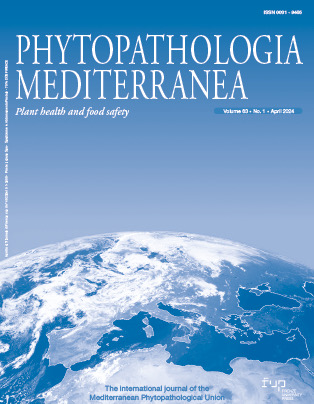Published 2024-04-29
Keywords
- Lycium barbarum,
- Pathogen identification
How to Cite
Copyright (c) 2024 Pingping SUN, Yuchen GUO, Lei ZHANG, Rong YANG, Zhengnan LI

This work is licensed under a Creative Commons Attribution 4.0 International License.
Abstract
In July 2022, root rot was observed in several goji (Lycium barbarum) orchards located in Qinghai Province, China. Approximately 40% of the goji plants were affected in the orchards. Morphology of fungi isolated from affected plant, phylogenetic analyses, using internal transcribed spacer (ITS), translation elongation factor 1-alpha (TEF), and trichothecene (Tri5) sequences, as well as pathogenicity assays, were conducted to characterize and identify the causing agent of goji root rot. Isolate GQGF1-3 caused typical symptoms of L. barbarum root rot. Fungal colony characteristics and conidium morphology, combined with ITS, TEF, and Tri5 sequences showed that isolate GQGF1-3 was Fusarium sambucinum. This is the first report of F. sambucinum causing root rot of goji.
Downloads
Metrics
References
- Alejandra A.S., Victoria A., Ibar T.S., Daniel N.A., 2019. Fusarium sambucinum Fuckel causal agent of fruit rot of manzano chilli pepper (Capsicum pubescens) in Mexico. Mexican Journal of Phytopathology 37: 159–169. https://doi.org/10.18781/r.mex.fit.1810-2
- Bai L., Li X., Cao Y., Song Z., Ma K., … Ma M., 2020. Fusarium culmorum and Fusarium equiseti causing root rot disease on Lycium barbarum (Goji berry) in China. Plant Disease 104: 3066. https://doi.org/10.1094/PDIS-11-19-2313-PDN
- Cariddi C., Mincuzzi A., Schena L., Ippolito A., Sanzani S. M., 2018. First report of collar and root rot caused by Phytophthora nicotianae on Lycium barbarum. Journal of Plant Pathology 100: 361–361. https://doi.org/10.1007/s42161-018-0076-0
- Chen S., Du J., Zhang T., Gu P., 2021. Studies on the pathogen of root rot of Lycium Barbarum in Ningxia. Journal of Agricultural Sciences 42: 7–11. (in Chinese)
- Du M., Ren X., Sun Q., Wang Y., Zhang R., 2012. Characterization of Fusarium spp. causing potato dry rot in China and susceptibility evaluation of Chinese potato germplasm to the pathogen. Potato Research 55: 175–184. https://doi.org/10.1007/s11540-012-9217-6
- Iwase C.H., Piacentini K.C., Giomo P.P., Čumová M., Wawroszová S., … Rocha L., 2020. Characterization of the Fusarium sambucinum species complex and detection of multiple mycotoxins in Brazilian barley samples. Food Research International 136: 109336. https://doi.org/110.1016/j.foodres.2020.109336
- Jia C., An Y., Du Z., Gao H., Su J., Xu C., 2023. Differences in soil microbial communities between healthy and diseased Lycium barbarum cv. Ningqi-5 Plants with Root Rot. Microorganisms 11: 694. https://doi.org/10.3390/microorganisms11030694
- Kitabayashi S., Kawaguchi A., Yoshida M., Kami D., Sugiyama K., Kawakami A., 2022. First report of Fusarium sambucinum causing postharvest fruit rot of winter squash (Cucurbita maxima). Journal of General Plant Pathology 88: 207–211. https://doi.org/10.1007/s10327-022-01053-w
- Lu Y., Guo S., Zhang F., Yan H., Qian D., … Duan J., 2021. Nutritional components characterization of Goji berries from different regions in China. Journal of Pharmaceutical and Biomedical Analysis 195: 113859. https://doi.org/10.1016/j.jpba.2020.113859
- Mishra P.K., Fox R.T., Culham A., 2003. Development of a PCR based assay for rapid and reliable identification of pathogenic Fusaria. Microbiology Letters 218: 329–332. https://doi.org/10.1111/j.1574-6968.2003.tb11537.x
- Nicholson P., Simpson D.R., Wilson A.H., Chandler E., Thomsett M., 2004. Detection and differentiation of trichothecene and enniatin-producing Fusarium species on small-grain cereals. European Journal of Plant Pathology 110: 503–514. https://doi.org/10.1023/B:EJPP.0000032390.65641.a7
- Potterat O., 2010. Goji (Lycium barbarum and L. chinense): Phytochemistry, pharmacology and safety in the perspective of traditional uses and recent popularity. Planta Medica 76: 7–19. https://doi.org/10.1055/s-0029-1186218
- White T.J., Bruns T.D., Lee S.B., Taylor J.W., 1990. PCR Protocols: A guide to methods and applications. in amplification and direct sequencing of fungal ribosomal RNA genes for phylogenetics, Academic Press, San Diego, California, United States of America, 315–322.
- Yikilmazsoy G., Tosun N., 2021. Characterization of Fusarium sambucinum isolates associated with potato dry rot and evaluation of cultivar susceptibility and fungicides. Turkish Journal of Agriculture and Forestry 45: 222–233. https://doi.org/10.3906/tar-2006-100
- Zhang Y., Qin J., Wang Y., Zhou T., Feng N., … Zhu M., 2022. Levels and health risk assessment of pesticides and metals in Lycium barbarum L. from different sources in Ningxia, China. Scientific Reports 12: 561. https://doi.org/10.1038/s41598-021-04599-5
- Zhu J., Chen L., Yao Q., Li Q., Chen H., Guo Q., 2023. Isolation and identification of pathogenic fungi and antagonistic bacteria from Lycium barbarum root rot. Acta Agriculturae Boreali-occidentalis Sinica 32: 1120–1130. https://doi.org/10.1016/j.biocontrol.2022.105120






